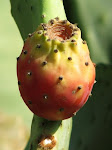The blue sign located above the souvenir stands (see picture below), indicates by the little white arrows , the direction to the synagogues (Maisel, Spanish, Pinkas, Old-New, Klausen), to the Ceremony Hall, and to the Old Jewish Cemetery- the major sites that make up the Old Jewish Quarter of Prague (Josefov). These historic-religious sites are visited every year by thousands of people from all over the world.
souvenirs in the Old Jewish Quarter
The above mentioned sites, display items belonging to the Jewish Museum in Prague: collections of jewish prints, manuscripts, books, silver ornaments, textile, traditions ,customs, and also lots of drawings by children from Terezin concentration camp.
The Pinkas synagogue is a Memorial to the czech victims of the Holocaust ; their names are written on its walls.
The Old-New synagogue ( the Altneushul) is the oldest in Europe, still in use as house of prayer. The Spanish synagogue hosts, besides exhibitions, also various concerts.
It is forbidden to take pictures inside the synagogues ( the interior of the Spanish synagogue with its moorish decorations is , in my opinion, the most beautiful); visitors can buy postcards, books and commemorative coins offered for sale on the spot.
The Old Jewish Cemetery is somehow peculiar and yet very impressive .
Although small, the cemetery contains thousands of graves from various historical periods; the oldest gravestone is from year 1439, and the last burial took place in 1787 .
It is said that the graves are put one upon another in some 12 layers! Many of the gravestones seem close to each other and inclined , probably because of lack of space.
The most prominent figure burried in this cemetery is Rabbi Jehuda Loew ben Bezalel (known as the MaHaRaL) a scholar and educator who has published more than fifty(50) religios and philosophical books. According to the legend, he created the Golem, a monster made of clay , brought to life through magic, who stood by the Jews in bad times, but later became violent and had to be destroyed.
One thing is obvios; no peace and quiet for the dead of this cemetery. It's constantly flooded with tourists taking pictures and wondering about the sights.














